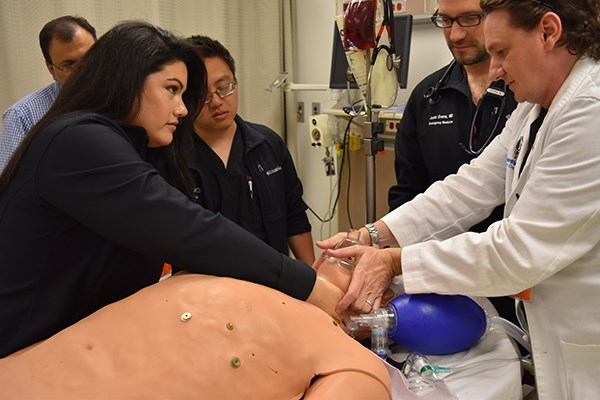Emergency medicine is well-regarded for its complete diversity in patient population and mix of clinical procedures. As a student interested in EM, one of the most daunting tasks is taking the initial steps to learn all the procedural skills that could be required in the emergency department. From IV placement to intubation and many others, there are plenty of skills to learn and be improved upon.
At best, not performing these skills correctly can make a patient uncomfortable (ie, multiple needle sticks) and at worst it can have morbid complications or death (ie, cardiac perforation or arrest from incorrect placement in pericardiocentesis). While that may be alarming to students, the best time to begin the procedural learning process is when you’re a student. With generally low expectations and high supervision from superiors, these four (or more) years of medical school can provide a great opportunity to make the transition to residency that much easier. Practicing procedures improves your confidence and skills. When it’s 3 a.m. and your eyes are a little fuzzy, you – and your patient – will be thankful for the muscle memory.
Interested? Here are a few tips for getting started.
- Nurses can be your best friends.
Generally, nurses receive far more training in school and on-the-job when it comes to venipuncture, IV placement, administering medications, placing Foley catheters, and managing all the machinery found in a patient room. This is a wealth of information that will help you as a medical student during clinical years and as a future physician. However, nurses are busy! The solution: Ask to shadow a nurse for a day, or go during a less busy time and ask a nurse to practice procedures. - YouTube is great, within reason.
Utilizing online materials that have not been verified is always a suggestion made with caution. However, a quick search will find thousands of videos both live and animated on virtually any procedure of interest. The suggestion: Use YouTube as way to brush up on skills that have already been explained or that explain the procedure in a different way. Make sure to view a few videos in order to catch similarities and get the full picture. Use your best judgment on this one. The New England Journal of Medicine has great clinical education videos that will demonstrate how to perform repairs from setup to clean up, as well as techniques. - Shadow other specialties.
While emergency physicians can perform several different types of procedures, there is no guarantee on how often these will present to the ED. Some other specialties, on the other hand, have more guaranteed access and volume. Want to learn and improve on intubations? Shadow anesthesia. Want to practice suturing? Shadow OB/GYN or surgery. Want to practice I&Ds? Shadow dermatology. EMS ride-alongs are also a great way to get, or maintain, exposure to the world of EM. This list is not all-inclusive, but remember a good working knowledge of most other specialties is important for diagnosis, treatment, and referral in EM. - Commercial kits
Many companies provide “skills practice kits.” A quick search will yield results for suturing, intubation, phlebotomy, etc. Some students find kits helpful while others find them largely unnecessary. As a warning, they tend to be expensive. - SimulationTalk to your school administrators about what simulation technology is available to medical students. If you’re interested in increasing simulation at your school, SIMS has free resources for medical students.
- Make-your-own kits
Getting a nice suture kit can be handy for practice and maybe even home use someday. Skin-on chicken breast or pig’s feet from a local butcher make for great practice because you will have at least 2 layers to work with, allowing you to practice deep sutures, subcuticular, and other standard techniques such as interrupted or running. Make different kinds of cuts and work on putting them back together. Straight, jagged, half-circles – you’ll be amazed how they can show up on-shift. - (Osteopath Students) practice Osteopathic Manipulative Treatment (OMT)
Specifically, I would encourage you to hone your skills for efficient evaluation, and also consider taking a Fascial Distortion Model (FDM) Module if one comes near you. FDM can be an effective and ultra-efficient method of treatment for patients in the ED. - The old-fashioned way
This is the tried-and-true advice you may have heard at some point during your education. Volunteer as often as possible, show initiative and interest, ask questions, and always try to understand the “why” of whatever skill you are doing.
Practicing some of your procedural skills can prove to be a fun and effective study break, all while helping you avoid the guilt of not having your nose in a book. The late golfer Samuel Snead once said, “Practice puts brains in your muscles.”
Above all, remember: Every nurse, attending, and resident went through this process. You have to start somewhere, so why not now?



